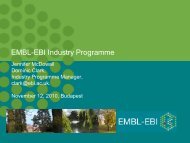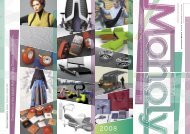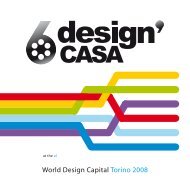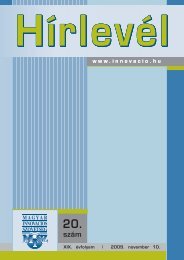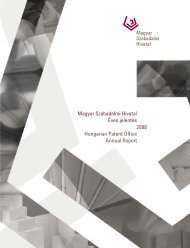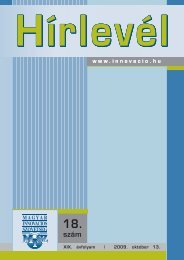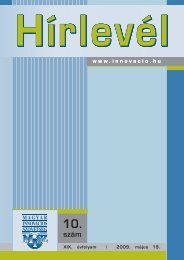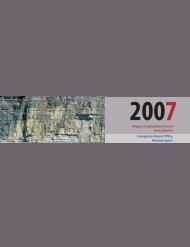Bonjour Mesdames, Messieurs,
Bonjour Mesdames, Messieurs,
Bonjour Mesdames, Messieurs,
Create successful ePaper yourself
Turn your PDF publications into a flip-book with our unique Google optimized e-Paper software.
T h e r e l a t i o n s h i p b e t w e e n t h e B e n e l u x a n d<br />
C o m m u n i t y s y s t e m s o f p r o t e c t i o n<br />
Presentation by<br />
Edmond Simon<br />
director general<br />
B e n e l u x O f f i c e f o r I n t e l l e c t u a l P r o p e r t y<br />
REGIONAL CONFERENCE ON THE COEXISTENCE OF THE COMMUNITY AND<br />
NATIONAL TRADE MARK SYSTEMS IN EUROPE<br />
Budapest, 3 November 2009
Ladies and Gentlemen,<br />
I would like to begin by expressing my heartfelt appreciation to the Hungarian Patent Office<br />
and in particular to President Bendzsel and Mr Ficsor for inviting me to this Conference and<br />
thus enabling me to be with you today. It has offered me the perfect opportunity to visit this<br />
wonderful city of Budapest again.<br />
My presentation today is on the relationship between the Benelux system and the Community<br />
system. Before addressing the issue itself, I would like to say a few words about the Benelux<br />
and my Organisation by way of general introduction.<br />
First of all, I must emphasise the fact that I am and will always be in favour of the CTM. It<br />
was designed for companies with commercial activities on the level of the Community: as a<br />
result our companies now pay lower fees to obtain registration of a European trade mark,<br />
administrative formalities are less onerous and it provides a single registration valid for the<br />
whole European Community territory. But I do have some misgivings, one of which is basic<br />
criticism on the way the system works. In no way should this be construed as expressing an<br />
anti-European attitude. I wanted to mention this at the start of my presentation as some people<br />
are averse to sound debate and for want of their own opinion, try to say that any criticism on<br />
the way the CTM works is a sign of opposition to the CTM itself. Well, in my case this is far<br />
removed from the truth! I just wanted to make that clear!<br />
And now a few words on the Benelux: the population is only 27 million in an area of just<br />
77,000 square km. So it is not very big. Nevertheless we manage to speak four official<br />
languages! With regard to trademarks and designs: our three countries no longer have national<br />
legislation – instead trade mark law is governed by the Benelux Convention on Intellectual<br />
Property (IP) and my Office is entrusted with its execution. To give you an idea of our<br />
workload: in 2008 we handled 24,000 Benelux filings, 13,500 Benelux renewals and 6,000<br />
international registrations with effect in the Benelux. For designs, the figures are even more<br />
modest! All the indicators are showing a downward trend, which is largely due to the success<br />
of the CTM. At the same time, the number of CTM registrations coming from the Benelux is<br />
steadily growing: there have been 30,262 registrations since the CTM came into force in<br />
1996, a figure which ranks the Benelux in seventh place on the international listings by state,<br />
far outstripping China and Japan!<br />
So it appears that Benelux companies are increasingly opting for the CTM and turning their<br />
backs on the Benelux trademark!<br />
One of the main reasons for this swing towards the CTM, at least in my opinion, lies in the<br />
fact that the term “territorial use” has not been legally defined for the CTM. And moreover,<br />
has been very narrowly interpreted by a non-competent authority.<br />
1- The CTM was adopted by the Council on 20 December 1993 in the form of EC<br />
Regulation 40/94 which I will refer to here simply as the „Regulation‟. Article 15,<br />
paragraph 1 of the Regulation says the following and I quote : “If, within a period of<br />
five years following registration, the proprietor has not put the Community trade mark<br />
to genuine use in the Community in connection with the goods or services in respect of<br />
which it is registered, etc etc,...” This article was clarified by a Joint Declaration of<br />
the Commission and Council of Ministers on 22 October 1995. I will refer to this
document as the „Declaration‟ (OJ-OHIM 5/96, pp.612-623) and it says the following:<br />
“The Council and the Commission consider that genuine use in the sense of Article 15<br />
in a single country constitutes genuine use in the Community”. The Declaration has no<br />
legal effect, nevertheless it is applied by OHIM in their procedures before the Office<br />
(cf. The Manual concerning Opposition – Part 6, p 13 ). In fact, in its website update<br />
of 20 June 2008, OHIM states, and I quote: “genuine use may be established when the<br />
trade mark is used just in part of the Community, such as a Member State or part of a<br />
Member State”. According to recent checks by colleagues of mine, it would appear<br />
that since then, this reference to a single state or even to part of a state has been<br />
deleted but not quite systematically!<br />
2- First of all let us remember that drafting the Regulation itself took several decades and<br />
the wording of Article 15 was revised twice before the final version as it appears in the<br />
Regulation today. This notion of use has never been reconsidered since the date of the<br />
Declaration even though the Community since then has considerably expanded its<br />
borders. From twelve Member States in 1995, today the Community has grown to<br />
twenty-seven Member States, covering some 4 million square km with a population<br />
approaching 500 million people. It is possible – even probable – that more Member<br />
States will join in the future. Consider Ukraine, Turkey, Croatia, Bosnia and<br />
Herzegovina, Serbia, Montenegro, Albania, the former Republic of Macedonia and,<br />
most recently, Iceland. Political analysis and discussion have begun and will continue<br />
in the years to come. If all these states were to join, the total territory of the EU would<br />
increase by a further 5 to 6% and the population by 27%.<br />
3- OHIM‟s correct application of this Declaration means that a CTM holder in<br />
Luxembourg, the country where I was born, simply by exercising his CTM in<br />
Luxembourg can claim exclusive rights to his CTM throughout the entire Community.<br />
But Luxembourg occupies only 0.05% of Community territory and has just 0.08% of<br />
the Community‟s population. The CTM nevertheless applies equally to the other<br />
99.2% of the Community‟s population.<br />
4- This is the same as local use, but on a European scale. It is out of all proportion<br />
because of (1) the vastness of the territory and the market covered by the CTM and<br />
(2) the exclusive rights of the trade mark holder against third parties. This<br />
disproportion is even more apparent if we bear in mind that this right used locally may<br />
be invoked against any company wishing to register an identical or similar trade mark<br />
in its own country or in other countries of its choice, even if the CTM holder has no<br />
intention of ever using his trade mark in that or those countries.<br />
5- From all this we are right in arguing whether the system as designed by the Regulation<br />
and interpreted by the Declaration might be used as an instrument to compartmentalise<br />
the internal market whereas the aim laid down in the First Directive 89/104/EEC of<br />
the Council of 21 December 1988 to approximate the laws of the Member States<br />
relating to trade marks (which I will refer to simply as „the Directive‟), was<br />
specifically to remove all the, and I quote, “disparities which may impede the free<br />
movement of goods and freedom to provide services and may distort competition<br />
within the common market.” Is this system still compatible with the wish of the<br />
European legislator as expressed in the second recital of the Regulation? That wish,
and I quote, was “to promote throughout the Community a harmonious development<br />
of economic activities and a continuous and balanced expansion by completing an<br />
internal market which functions properly and offers conditions which are similar to<br />
those obtaining in a national market.” Does it, and I quote, “open up unrestricted<br />
economic activity in the whole of the common market for the benefit of undertakings”,<br />
as laid down in the fourth recital of the Directive?<br />
6- Our own legislation in the Benelux has been dealing with opposition proceedings only<br />
since 2004 and statistics show that Benelux applicants (mostly SMEs) are facing more<br />
and more proceedings based on a CTM ( 54.6% in the last thirteen months ) , although<br />
I want to point out once again that a CTM does not need ever to be used in the<br />
Benelux in order to be a valid registration. There are several reasons for the increase,<br />
but one could be that trade mark holders should be more alert in order to avoid falling<br />
into the trap of limitation in consequence of acquiescence, another principle of<br />
Community law (Directive, article 9). This percentage of oppositions based on a CTM<br />
is steadily and continuously increasing (by 15% up in less than two years) and there is<br />
no reason to believe that this increase will come to an end in the future. Every year,<br />
applicants for Benelux trademarks are effectively confronted with more than 100,000<br />
new CTMs (either directly through OHIM or via the Madrid Protocol), whereas the<br />
“Benelux market” itself rarely exceeds 30,000 trademark registrations (and this<br />
includes international registrations with effect in the Benelux).<br />
7- These constraints hardly encourage SMEs ,which are the very heart of the Lisbon<br />
Strategy, to file their trade mark applications on a national level, despite the fact that<br />
the Regulation starts from the principle that , and I quote, “national trade marks<br />
continue to be necessary for those undertakings which do not want protection of their<br />
trade marks at Community level”. To actually check the availability of their trade<br />
marks, SMEs must now search through three registers: the national/ Benelux register<br />
(with a requirement for use), the international register (with a requirement for use in<br />
the designated states) and above all in the Community register where tens of thousands<br />
of trade marks are registered every year and where the validity is not affected by nonuse,<br />
even over time in 26 Member-States of the Community. As I said in the case of<br />
my home country Luxembourg, it could mean up to 99.92% of the Community‟s<br />
population and 99.95% of the Community territory. This simply leads to a Lawyers’<br />
Paradise where any balance between the three registration systems has vanished. This<br />
affects all proprietors of trademarks, whether they go down the national, international<br />
or community route. It is certainly not in the spirit of the so-called “Kok report” on the<br />
Lisbon Strategy in which a High Level Group recommended that the protection of<br />
intellectual property should be made more accessible to SMEs by reducing the costs.<br />
8- This has been all the more true since the Community's accession to the Madrid<br />
Protocol in 2004, some nine years after the Declaration. This Protocol grants those<br />
Member States signatory to the Protocol easy access to the Common Market in order<br />
to assert their exclusive rights. The reverse, however, is not possible under the same<br />
conditions . Whereas businesses in China, the USA, Japan and the Russian Federation<br />
are able to use the CTM system to impose their own trade marks on Benelux<br />
companies without ever using them on Benelux territory, this is manifestly not the<br />
case for those Benelux businesses that wish to impose their rights on the same<br />
companies in their respective countries. They actually have to prove genuine use in
each of the States where they want to maintain their rights. On top of this and in view<br />
of future developments we cannot lose sight of the fact that several of these States,<br />
including China and the Russian Federation for example, show enormous economic<br />
potential probably resulting in a booming number of trade mark filings. China has<br />
already become number one in the world of trademark filings! The same economic<br />
potential can also be seen in Brazil and India which, as we all know, are preparing to<br />
sign the Madrid Protocol.<br />
9- This all goes to show that the notion of use related to the borders of a single<br />
country,or even part of a single country, must be dropped as a general principle. It has<br />
no place in a Common Market characterised by the free movement of goods and<br />
services and an absence of economic barriers. A CTM is protected across the<br />
Community and there must be genuine and effective use to justify this protection of<br />
exclusive rights, in the same way that genuine and effective use is a requisite in<br />
national and international registration systems. This would be in line with the wish of<br />
the European legislator expressed in the second recital of the Regulation, mentioned<br />
above, regarding the operation of the internal market. Inspiration could be drawn from<br />
the CFI judgement in case no. T-39/01 dated 22 February 2003 . I quote from<br />
Consideration 37: „… this use implies that the trade mark is present on a substantial<br />
part of the territory in which it is protected through exercise of the essential function<br />
innate to it, in other words, to identify the commercial origin of the product or service<br />
in order to enable the consumer buying the product or service designated by the trade<br />
mark, to choose the same product or service in future or to buy another, depending on<br />
the experience etc etc…” To follow the CFI in this matter would ultimately bring us<br />
back to the version of Article 15 as proposed in the "Memorandum on the Creation of<br />
an EEC Trade mark" in 1976. This document referred clearly, and I quote “use in a<br />
substantial part of the common trade market”.<br />
Ladies and Gentlemen, I am fully aware that my presentation is more political than legal.<br />
The Regulation itself, apart from the Recitals I have just quoted, offers few legal<br />
arguments in support of wider territorial use. One exception is Article 112 paragraph 2<br />
indent a. In my opinion this is the only Article in the entire Regulation which presents an<br />
implicit argument to contest the validity of the Declaration. This Article, according to<br />
some authors, could be interpreted a contrario in that sense that the CTM can be<br />
invalidated for not having been used according to Article 15 of the Regulation although<br />
the CTM was put to genuine use in one or more Member States. I share this interpretation<br />
because it is completely in line with the first Recitals of the Regulation as I understand<br />
them: the CTM was designed for companies with commercial activities on the level of the<br />
Community and not for companies without commercial activities on Community level. It<br />
is as simple as that!<br />
Article 112 does not make any sense if the validity of the Declaration was to be<br />
recognized!<br />
Now let us come back to the Benelux: local use or genuine use limited to one single Benelux<br />
country as a general principle is also hard to reconcile with a decision made by our own<br />
Benelux Court of Justice on 17 January 1981 in the well known Turmac/Reynolds case. The<br />
Court was asked by the Dutch Supreme Court which criteria should be taken into account for
establishing genuine use in the Benelux. As to the criteria the Court ruled that all the facts and<br />
circumstances such as kind of use, territorial scope, frequency, regularity and duration of use,<br />
the kind of product and the kind and dimension of the company have to be taken into account<br />
in their mutual relations. It was therefore not necessary that the trademark be used throughout<br />
the entire Benelux . But, ladies and gentlemen, you will understand immediately that we are<br />
very far away from the Declaration of 1995 establishing use in one Member State as a<br />
general principle! And why do I refer to this decision of our Benelux Court, which dates back<br />
to 1981 – long before the Regulation came into force? The reason is that the CTM and our<br />
own Benelux trademark have some similarities .We also have one single trademark with a<br />
unitary character for the whole Benelux territory and this territory is composed of three<br />
different countries of different sizes. The Benelux is made up of one large, one medium and<br />
one very small country. No fewer than four official languages are spoken in addition to<br />
various dialects. Moreover, the Benelux legislators created the Benelux trademark some fifty<br />
years ago for one reason : to ensure the free movement of goods within the Benelux<br />
Economic Union . It is a principle later adopted by the European Union and anchored in the<br />
first Recitals of the Regulation.<br />
But I admit that genuine use has now become Community law and that in the end it will be<br />
up to the Court of Justice of the European Communities to have the last word!<br />
I find the recent CJ judgement of 6 October 2009 in the PAGO case to be extremely<br />
disappointing, while the conclusions of AG Sharpston regarding the Community territory as a<br />
whole seemed totally convincing to me ! To go back to my little home country, Luxembourg,<br />
if I am reading the judgement correctly, 0.05% may now be considered to constitute a<br />
„substantial part‟ of the territory of the Community!! Surely this is a contradiction in terms!<br />
But, Ladies and Gentlemen, all is not lost! The Commission has recently begun a study into<br />
the operation of the CTM system as a whole. It will amongst other things examine the issue of<br />
territorial use of the CTM (Evaluation question (2) Relation between CTM system and<br />
national trade mark systems (ii) Requirement for a CTM to be used “in the Community”) . It<br />
is my fervent hope that all those asked to respond to the questionnaire do so carefully and that<br />
the outcome will be balanced and based on consideration of the trademark landscape shaped<br />
on three different registration systems : national, European and international, and the<br />
knowledge that these three systems complement each other, with each responding to different<br />
needs .<br />
I am definitely not ruling out the possibility that a case of my Office will soon be brought to<br />
the Court of Justice with different prejudicial questions relating to Article 15, paragraph 1 of<br />
the Regulation. It is about an opposition proceeding between a Dutch CTM holder and a<br />
Benelux trademark holder. The CTM holder exercises his trademark only on Dutch territory<br />
(they offer legal services to SMEs based in the Netherlands ) ; the Benelux trademark holder<br />
does not exercise his trademark in the Benelux but he needs it in order to obtain an<br />
international registration for Sweden , an EU Member State and signatory to the Madrid<br />
Protocol, and for Norway , a non-EU Member State, but signatory to the Madrid Protocol.<br />
The CTM holder is seeking to stop the Benelux trademark holder to get a trademark right in<br />
an other EU Member State whereas there is no overlap between the two markets and at the<br />
same time obstruct the Madrid Protocol route. According to me this is a case in point to<br />
illustrate where the aberrant situation, caused by such a narrow interpretation of CTM<br />
territorial use, can lead to.
The huge general interest represented by the free movement of goods and services which lies<br />
at the very heart of the Single Market deserves very prompt clarification by the one and only<br />
authority competent to interpret the Regulation, namely the Court of Justice of the European<br />
Communities. Besides, it would not be the first time that the Court of Justice overruled the<br />
Declarations (see for example the decision of the Court of Justice of 7 July 2005 relating to<br />
„retail trade‟) and neither would it be the first time that the Court of Justice very quickly<br />
turned 180 degrees on their former jurisprudence (see for example the COMPANYLINE<br />
decision of 12 January 2000 compared to their BABY-DRY decision of 8 July 1999 ).<br />
So let‟s not lose hope and I trust you will rise to the challenge in the next few months. Of<br />
course I will keep Mr Ficsor informed about the progress of the proceeding. I am quite aware<br />
how much the Hungarian Patent Office cares about their SMEs as they play a more than vital<br />
role in our national economies. And I am absolutely certain that the same applies to Antonio<br />
in Portugal, his home country.<br />
Once again I would like to thank you so much for the privilege of being with you today and<br />
for listening to me so patiently.<br />
- END -



